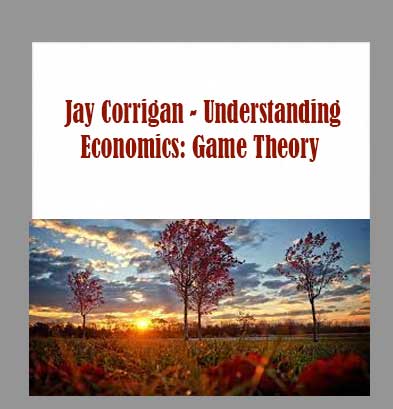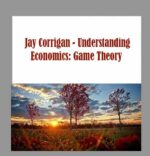Description
Jay Corrigan – Understanding Economics: Game Theory download, Jay Corrigan – Understanding Economics: Game Theory review, Jay Corrigan – Understanding Economics: Game Theory free
Jay Corrigan – Understanding Economics: Game Theory
Understanding Economics: Game Theory
Optimize your life with game theory-the study of how people make decisions. An award-winning teacher explains the basics.
LECTURE (12)
01:Game Theory Basics: The Prisoner’s Dilemma
Begin your study of game theory by considering the difference between a decision and a game. Then look at two key concepts, dominant strategy and the Nash equilibrium—the latter named for mathematician John F. Nash, profiled in the movie A Beautiful Mind. Use these ideas to interpret the notorious prisoner’s dilemma, where two rational individuals with strong incentives to cooperate choose not to.
02:Repeated Prisoner’s Dilemma Games
Take prisoner’s dilemma to the next level, where the game is played not just once, but repeatedly. Contrast the equilibrium strategy with what real people typically do. Examples include trench warfare during World War I, when the two sides often fell into a live-and-let-live equilibrium, and the price-fixing scheme among many US colleges that set tuition and financial aid grants for three decades.
03:The Game of Chicken
Learn to analyze strategy in the game of chicken, in which two cars barrel toward each other and the first to veer away is the loser. Versions of chicken play out in nature in the competition among animals for mates, and in the US Congress, where budget battles with the president risk government shutdown if neither side yields. See how chicken differs in crucial ways from the prisoner’s dilemma.
04:Reaching Consensus: Coordination Games
Turn from games of conflict to those of coordination—for example, when companies must decide between competing standards where it’s in everyone’s best interest to make the same choice. Historically, the triumph of VHS for videorecording over Betamax shows that the superior standard doesn’t always prevail. Discover that all coordination games have more than one Nash equilibrium.
05:Run or Pass? Games with Mixed Strategies
Whether they realize it or not, football coaches use game theory when choosing offensive and defensive strategies. Obviously, they want to keep the other team guessing, which means being unpredictable in ways that maximize the average gain per play. This approach is called a mixed strategy. See how it also applies for stores scheduling sales to keep consumers guessing—and buying.
06:Let’s Take Turns: Sequential-Move Games
Now look at sequential-move games, where players take turns. Examples include the strategies involved when Congress passes a bill and the president must decide whether to veto it. Also analyze the ultimatum game, a classic of behavioral economics in which an allocator proposes a division of money and a decider either accepts the split or rejects it so that both sides get nothing.
07:When Backward Induction Works—and Doesn’t
The strategy of backward induction starts at the last decision in a game and then reasons back to the beginning. Although this is an effective approach, it can produce strange results. Explore several examples, including a game created by Nobel Prize-winner Reinhard Selten. Learn why real players often resist using backward induction for a good reason, whether they realize it or not.
08:Asymmetric Information in Poker and Life
Many situations in life involve interactions where one party has critical information not available to the other. A classic case is poker, where this asymmetry adds spice to the game. A more stressful example is buying a used car, where the seller’s knowledge of the vehicle’s true condition puts the buyer at a disadvantage. Consider the role of signaling in reducing this asymmetry.
09:Divide and Conquer: Separating Equilibrium
Ever wonder why coach seats are so cramped? The airlines’ challenge is to make the first-class and coach experiences different enough to lure free-spending passengers to first class without making economy travelers so miserable they won’t fly. See how game theory explains this practice. Then discover that dueling may have evolved to correct the problem of asymmetric information in loaning money.
10:Going Once, Going Twice: Auctions as Games
Life is full of negotiations that are, in fact, auctions—from buying a house to accepting an airline’s offer of a voucher on an oversold flight. Study four types of auctions, including the second-price auction, in which the winner pays the second-highest bid. This approach encourages participants to offer the true amount they’re willing to pay. Learn strategies for each type of auction.
11:Hidden Auctions: Common Value and All-Pay
Focus on common-value auctions, where the item for sale has the same value to everyone who’s bidding on it. The problem is, no one knows what that value is. In these cases, it’s easy to overbid and fall victim to the winner’s curse—paying more for an asset than it’s worth. Get tips on how to avoid this pitfall. Also, look at all-pay auctions, where everyone—not just the winner—pays what they bid.
12:Games with Continuous Strategies
Close by seeing the power of calculus for analyzing games with continuous strategies (no prior experience with calculus needed). Examples include gunboat tactics to combat pirates, and bull elk competition in antler growth with the goal of attracting mates. Not only does game theory explain the way people behave in strategic interactions, but it can also lead to insights about the animal world!
Â
DETAILS
Overview
Taught by Professor Jay R. Corrigan, an award-winning teacher at Kenyon College, this course introduces you to game theory, which is the study of how people make strategic decisions in business, commerce, and a host of other activities. Focusing on the fundamentals, Professor Corrigan explains the principles of games and the best strategies, while opening your eyes to the games going on all around you.
Â
About
Jay R. Corrigan
Game theory is a highly effective way of looking at and better understanding strategic behavior from every part of life.
ALMA MATER
Iowa State University
INSTITUTION
Kenyon College
Jay R. Corrigan is a Professor of Economics at Kenyon College. He earned a BA in Economics from Grinnell College and a PhD in Economics from Iowa State University.
Professor Corrigan’s writing has appeared in The Washington Post and Barron’s. His scholarly publications in economics, public health, and substance abuse journals have been cited more than 1,000 times. His research has been covered by news outlets such as ABC, NBC, and BBC World News, and his work was included in a Washington Post list of the 10 best works on political economy in 2018.
Professor Corrigan is a recipient of Kenyon College’s Trustee Teaching Excellence Award, and The Princeton Review named him one of America’s best college professors.








